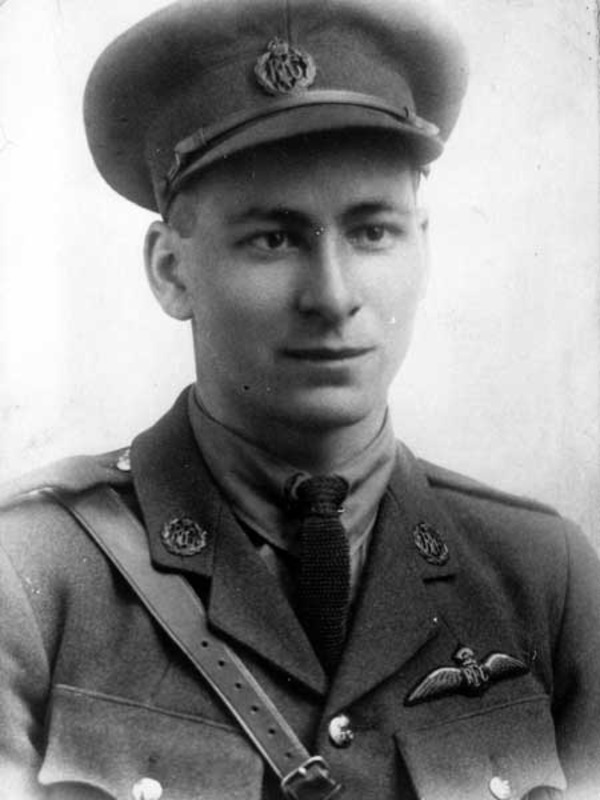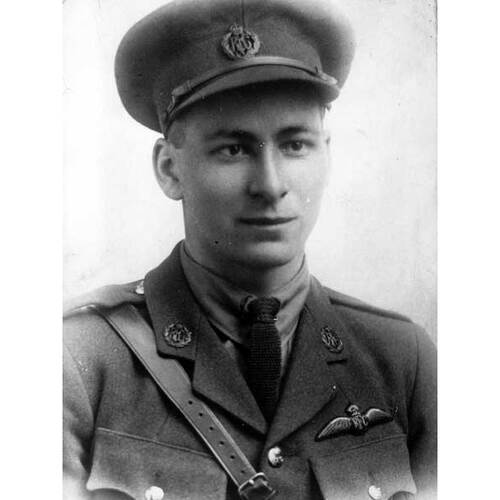
Source: Link
STEVENSON, FREDERICK JOSEPH, air force officer and bush pilot; b. 2 Dec. 1896 in Parry Sound, Ont., fourth of the five children of Annie Laurie Quinn and Joseph Stevenson; d. unmarried 3 Jan. 1928 in The Pas, Man.
When Frederick Joseph Stevenson was a young child his father, a superintendent of railway bridge construction, was transferred to Saskatchewan. Stevenson, known as Steve, was a good student, loved baseball, and spent many summers with his father tenting, while his father checked bridges throughout the province. He came to enjoy the outdoors and learned wilderness survival skills which would serve him well as a bush pilot. After high school he worked for the Bank of Hamilton at a branch in Saskatchewan, probably at Vonda, and then in Winnipeg, where in 1916 he enrolled at Wesley College. Shortly afterwards, he enlisted in the 196th Battalion and was sent to Seaford, England. While in the infantry he was wounded. The lure of Royal Flying Corps aircraft stationed nearby was strong and Stevenson joined the RFC in the summer of 1917. He served with 79 Squadron, flying Sopwith Dolphin fighters. Credited with destroying three observation balloons and 18 enemy aircraft, he was awarded the Distinguished Flying Cross on 3 June 1919, but the citation gave no details as to which of the accomplishments earned him the award. He is also reported to have been awarded the French and the Belgian Croix de Guerre and to have been mentioned in dispatches. He ended the war with the rank of captain.
Unlike most wartime pilots, Stevenson found work as a pilot after the war. First, with the Royal Air Force, he flew delegates and dispatches between London and Paris during the Peace Conference of 1919. He next taught White Russians in the Crimea how to fly. For this service he was awarded the Order of St Stanislaus. In 1920 he joined the Canadian Aircraft Company in Winnipeg, gave exhibitions of aerobatic flying, transported passengers, and barnstormed throughout Manitoba. From 1924 to 1926, with the newly organized Ontario Provincial Air Service, he flew forestry patrols from bases at Sault Ste Marie, Sioux Lookout, and Sudbury. In 1927 he joined James Armstrong Richardson*’s Western Canada Airways. With the new company he made many trips but three operations were considered epic-making and earned him the reputation of being Canada’s leading commercial pilot.
The first series of flights was between Cache Lake, Man., at the end of the rail line, and Fort Churchill, during March and April 1927. One of two pilots, Stevenson made 27 round trips in 30 days, flew 6,093 miles, and transported 17,894 pounds of material and 14 men so that exploratory drilling of Fort Churchill’s harbour could be undertaken that year. The flights were significant as the first large airlift operation in Canada. They also determined the selection of Fort Churchill as the ocean terminus of the Hudson Bay Railway. The second operation occurred between August and October 1927. Stevenson, flying 12,542 miles in 28 days, transported 23 tons of mining equipment from Cormorant Lake to Cold Lake (northeast of Flin Flon). This operation was the largest freighting contract in North America to that time. More important, it proved to the mining industry that it was more economical to fly in equipment than to pay men to pack it into the bush. During the third trip, in December 1927, Stevenson made a 600-mile return flight from The Pas to Reindeer Lake. Although no details are given in the company’s files, likely the importance of this flight was its length and the time of year.
Stevenson’s flights helped to establish the usefulness of aircraft in peacetime and in remote areas. At the end of World War I most Canadians looked on flying as a military venture or as a frivolous past-time and saw no use for flying in peacetime. Stevenson helped to change the image of the airplane. He showed how it could open up the north by transporting bulky and heavy freight into distant and generally inaccessible areas. Under the WCA’s banner he initiated freighting by air. His pioneering flights were made under primitive conditions; there were often no landing fields, no lighting, no navigation or radio aids, no facilities such as hangars in which to do repairs, and only sketchy maps. In addition, the aircraft were not built to operate in extreme cold and frequently broke down away from base. The pilot, moreover, sat in an open cockpit.
Stevenson was well-suited to these pioneer flights, however. His easy-going attitude was ideal for an environment which had no established way of doing things and where each flight was an experiment. Equally important, he was a risk-taker and an innovative thinker, as evidenced by his tying toboggans to the wheels of his aircraft so that he could land on snow.
On 5 Jan. 1928, after his Fokker Universal aircraft, G-CAGE, had been repaired, he successfully test flew the plane, but crashed while attempting to land and was killed. Pilot error was the cause. His brilliant flying and his contributions to the advancement of aviation were quickly recognized. In 1928 he was posthumously awarded the Harmon Trophy for Canada for the previous year. Also in 1928 Winnipeg’s municipal airfield was named Stevenson Aerodrome in his honour. That January the WCA had nominated him, unsuccessfully, for the top Canadian aviation trophy, the McKee Trophy. Seven months later the government of Manitoba named a northern lake and a river after him. In 1964 the St James–Winnipeg Airport Commission had a bronze bust of him, sculpted by Cecil Richardson, mounted on a pedestal at the airport. In 1973 a Winnipeg school was named in his honour. All of Stevenson’s medals are displayed at Winnipeg International Airport.
AM, MG 11, A34; P 3361. Western Canada Aviation Museum (Winnipeg), F. J. Stevenson file. Winnipeg Free Press, 19 Oct. 1936, 13 July 1970. Winnipeg Tribune, 16 Dec. 1972. Peter Corley-Smith, Barnstorming to bush flying: British Columbia’s aviation pioneers, 1910–1930 (Victoria, 1989). F. H. Ellis, Canada’s flying heritage (Toronto, 1954; rev. ed., 1961). G. A. Fuller et al., 125 years of Canadian aeronautics: a chronology, 1840–1965 (Willowdale, Ont., 1983). K. M. Molson, Pioneering in Canadian air transport ([Winnipeg], 1974). D. F. Parrott, Harold Farrington, pioneer bush pilot (Thunder Bay, Ont., 1982). S. L. Render, “Canadian Airways Limited” (ma thesis, Univ. of Man., Winnipeg, 1984). A. G. Sutherland, Canada’s aviation pioneers: 50 years of McKee Trophy winners (Toronto, 1978). Bruce West, The firebirds ([Toronto], 1974).
Cite This Article
Shirley Render, “STEVENSON, FREDERICK JOSEPH,” in Dictionary of Canadian Biography, vol. 15, University of Toronto/Université Laval, 2003–, accessed January 18, 2026, https://www.biographi.ca/en/bio/stevenson_frederick_joseph_15E.html.
The citation above shows the format for footnotes and endnotes according to the Chicago manual of style (16th edition). Information to be used in other citation formats:
| Permalink: | https://www.biographi.ca/en/bio/stevenson_frederick_joseph_15E.html |
| Author of Article: | Shirley Render |
| Title of Article: | STEVENSON, FREDERICK JOSEPH |
| Publication Name: | Dictionary of Canadian Biography, vol. 15 |
| Publisher: | University of Toronto/Université Laval |
| Year of publication: | 2005 |
| Year of revision: | 2005 |
| Access Date: | January 18, 2026 |



